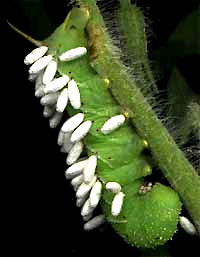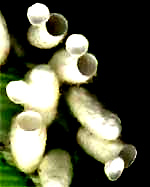Excerpts from Jim Conrad's
Naturalist Newsletter
from the September 7, 2003 Newsletter issued from the woods just east of Natchez, Mississippi, USA
BRACONID WASP COCOONS ON HORNWORM
 Earlier I reported that Tobacco Hornworms were enjoying my tomato vines, and that I'd watched a flesh fly laying eggs or larvae on a caterpillar's skin. Wednesday I noticed two more ill-looking hornworms. One had that bruised, moist look of a caterpillar who had been harassed by a flesh fly, but the other looked completely different. It was normal except that it was covered with 34 little white cocoons about 1/8 inch long (3.5 mm) and shaped like wieners. These cocoons were not made by flesh fly maggots but rather by one of many species of Braconid Wasp. My scanned image of the same cocoon-covered hornworm I saw is shown at the right.
Earlier I reported that Tobacco Hornworms were enjoying my tomato vines, and that I'd watched a flesh fly laying eggs or larvae on a caterpillar's skin. Wednesday I noticed two more ill-looking hornworms. One had that bruised, moist look of a caterpillar who had been harassed by a flesh fly, but the other looked completely different. It was normal except that it was covered with 34 little white cocoons about 1/8 inch long (3.5 mm) and shaped like wieners. These cocoons were not made by flesh fly maggots but rather by one of many species of Braconid Wasp. My scanned image of the same cocoon-covered hornworm I saw is shown at the right.
Braconids are small wasps, and you can bet that my hornworm with 34 cocoons stuck to him will not metamorphose into a sphinx moth, for recently that caterpillar has been tunneled through by at least 34 little maggots who ate much of his interior body.
Braconids, along with very closely related Icheneumon Wasps, are important in controlling caterpillar populations. You may have seen them sold in gardening magazines as biological control agents.
During the last couple of weeks I haven't seen a single hornworm who wasn't obviously dying from either a flesh fly or Braconid visit. In the spring when my tomato vines were small and every leaf and bud was a treasure, I may well have presented what hornworms I found to my favorite Fence Lizards or skinks, but right now, by leaving my hornworms alone, I think of myself as feeding the Braconids and flesh flies who next year will help keep down my hornworm population.
from the September 14, 2003 Newsletter issued from the woods just east of Natchez, Mississippi, USA
BRACONID WASP ADULTS ESCAPE FROM COCOONS
 Last week I told you about the braconid wasp cocoons hanging on the Tobacco Hornworms on my tomato vines. On this Sunday morning the hornworms are still hanging there, but only empty cocoons adorn their bodies. I know the cocoons are empty because the cocoons' ends opposite the point of attachment with the hornworms' bodies have been slit open from within, and now the cocoon tips are thrown back like the lids of pots with hinged tops. I got the fine scanning of several empty cocoons, clearly showing their thrown-back tops, seen at the right.
Last week I told you about the braconid wasp cocoons hanging on the Tobacco Hornworms on my tomato vines. On this Sunday morning the hornworms are still hanging there, but only empty cocoons adorn their bodies. I know the cocoons are empty because the cocoons' ends opposite the point of attachment with the hornworms' bodies have been slit open from within, and now the cocoon tips are thrown back like the lids of pots with hinged tops. I got the fine scanning of several empty cocoons, clearly showing their thrown-back tops, seen at the right.
Though my hornworms have been covered with braconid wasp cocoons for at least a couple of weeks now, the hornworms themselves are still alive. I don't believe they have moved at all during the last week, but if you touch them they still have the strength to draw up their heads a little.